Professional Email Format Guide: Templates + Best Practices
Jenny Keohane
Sending a business message in proper email format immediately demonstrates professionalism and credibility.
Whether you’re sending a cold email to a prospect, emailing your boss, reaching out to a client, submitting a job application, or messaging a professional contact – formation makes all the difference.
Below, we cover proper business email format, best practices for improving your email outreach, and professional email templates for various use cases.
Here’s what we’ll cover:
- How to Format Your Professional Emails
- Email Format Best Practices
- Professional Email Message Templates
How to Format Your Professional Emails
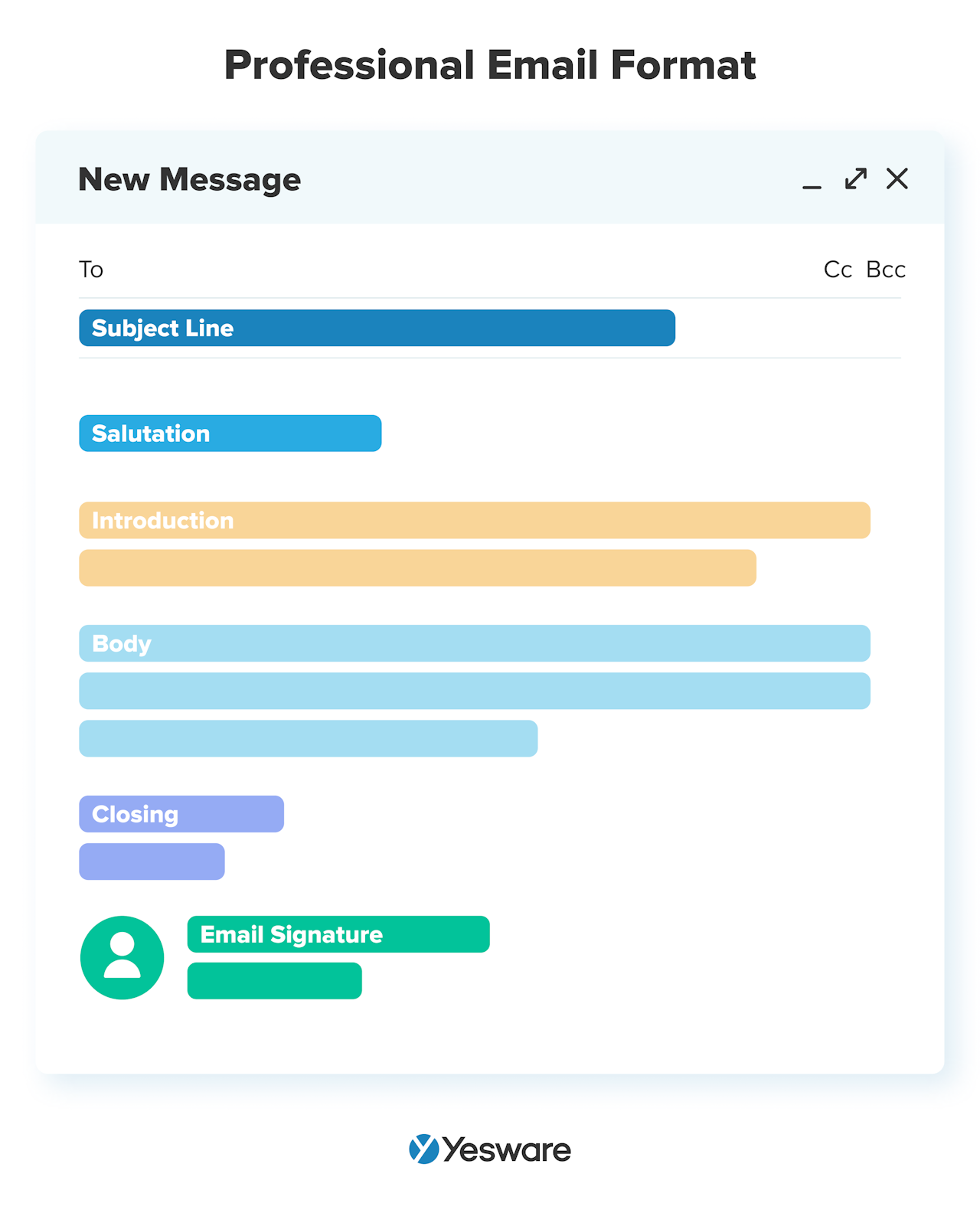 Here are the essential elements of a professional email:
Here are the essential elements of a professional email:
- Subject Line: Summarize what your email is about in a clear and concise way.
- Salutation: Greet your recipient with an appropriate salutation for the situation.
- Introduction: Provide a brief summary of who you are.
- Body: Write a few short paragraphs about why you’re reaching out and end with a CTA.
- Closing: End your email with a personalized closing.
- Email Signature: Always include an email signature with contact information.
Now let’s see these in action. 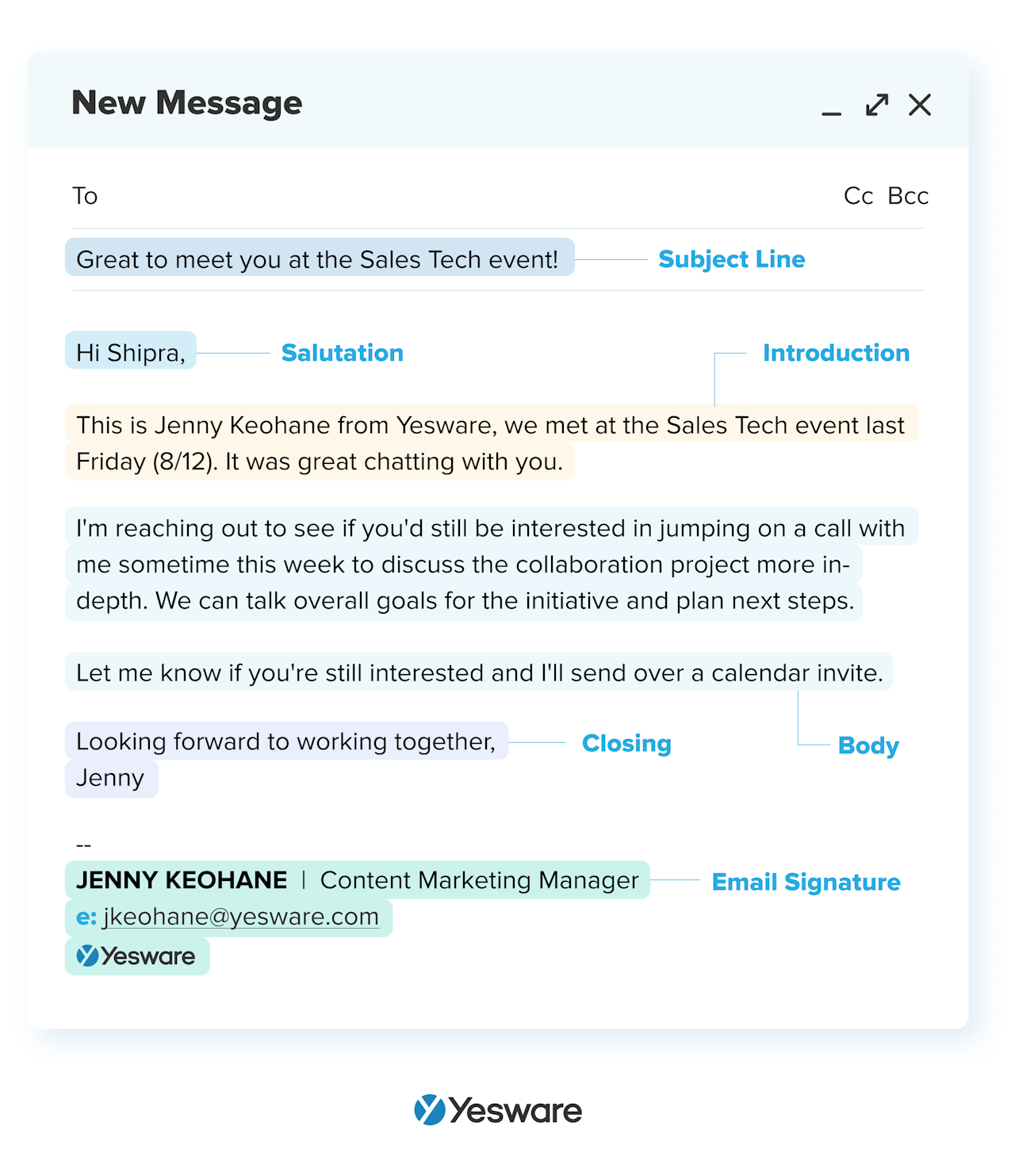 We’ll break down each element below with examples and templates.
We’ll break down each element below with examples and templates.
Professional Email Format
1. Subject Line
If you don’t have the right subject line, your email format won’t matter. Your well-spent words will go from your keyboard to the recipient’s trash can.
Provide a quick explanation of what’s inside your email in a clear and concise way; effective subject lines typically fall around 1-7 words. But remember to also make it appealing enough that the recipient wants to open your email.
In a cold email subject line study, we found that these elements significantly increased open rates:
- Personalize your subject lines
- Ask questions to generate curiosity
- Include numbers for increased engagement
- Address pain points to elicit emotion
- Provide value to catch their eye
Tip: Avoid all caps and multiple exclamation points. These are the two most common patterns that get flagged by spam filters.
2. Salutation/Greeting
What’s the most effective way to open up a conversation via email?
According to studies, the best email greeting may be the most obvious: Hi {!First Name},
Try using “Hello” and “Hi” rather than “Hey” in professional and formal emails to avoid coming off as non-professional or too casual to your recipient. It’s the safest route and studies show it’s most effective.
If you want more email greetings, Grammarly suggests the six best ways to start an email are:
- Hi [Name],
- Dear [Name],
- Greetings,
- Hi there,
- Hello, or Hello [Name],
- Hi everyone,
Your greeting is your recipient’s first impression of you – so play it safe. The last thing you want is them clicking away before getting to the content of your message.
3. Introduction
Never get into the body of the message without introducing yourself. It adds the additional element of mannerism and professionalism to your message.
Provide a brief summary of who you are and why you’re reaching out.
Once you introduce yourself, then you can get into your ask (the body of your message). But your ask will fall flat without a proper introduction.
Tip: Including a line about the recipient in your introduction immediately grabs their attention and starts your email off on the right foot. Here are some examples:
- I saw your post about [topic]
- Congratulations on [achievement]
- Great insights on [topic]
- I’m inspired by the work you’ve done on [field]
4. The Body of Your Message
The next element of professional email format is the body of your message. This is where you illustrate the purpose of your email.
Remember, the shorter and more concise, the better.
Here’s what to include:
- Explain why you’re reaching out: In a few short paragraphs explain the reason for your email.
- The ask: If you’re asking for something, make this clear, followed by a call to action.
- Include a CTA: What’s next? Provide the next steps and what you’re looking for from the recipient.
Keep your email about one topic and avoid asking multiple questions or writing lengthy sentences.
5. Closing
Lastly, your sign-off. You should end your email on a friendly note.
If you want to keep it simple, here are some of the most common closing phrases for professional emails:
- Best,
- Best Regards,
- All the best,
- Thank you,
- Thanks again,
- With appreciation,
- Regards,
- Sincerely,
- Talk soon,
If you want to take a more personalized approach, tailor your sign-of to align with the context of your message.
When you’re requesting/scheduling a meeting:
- Looking forward to meeting with you,
- Looking forward to working with you,
- Thanks in advance for your time,
When you need feedback or a task completed:
- I sincerely appreciate your help,
- Looking forward to your reply,
- Thank you and let me know if there are any hold-ups,
When you’ve completed a project:
- It was great working with you,
- Looking forward to collaborating again in the future,
- Thanks for all your hard work on this,
6. Email Signature
Last but not least, your email signature provides the recipient with your contact information and relevant links.
What to include in your email signature:
- Name, position, company name
- Contact information
- Social media buttons to call your recipient to connect with you
- Extra: Your headshot — this reminds your recipient that there’s a living, breathing human on the other side of the screen
Here’s an example of a strong email signature:

Here’s a basic email signature template for you to grab:
Name
Position | Company Name
Phone/Email
Website
Email Format Best Practices
1. Make the Body of Your Email Short and Scannable
Want to know an easy way to lose your recipient? Bury them with information.
Always make sure your ask is clear and that the recipient knows why you’re reaching out and why they should care about responding.
A way you can do this is by using bold words to draw the recipient’s attention to important information.
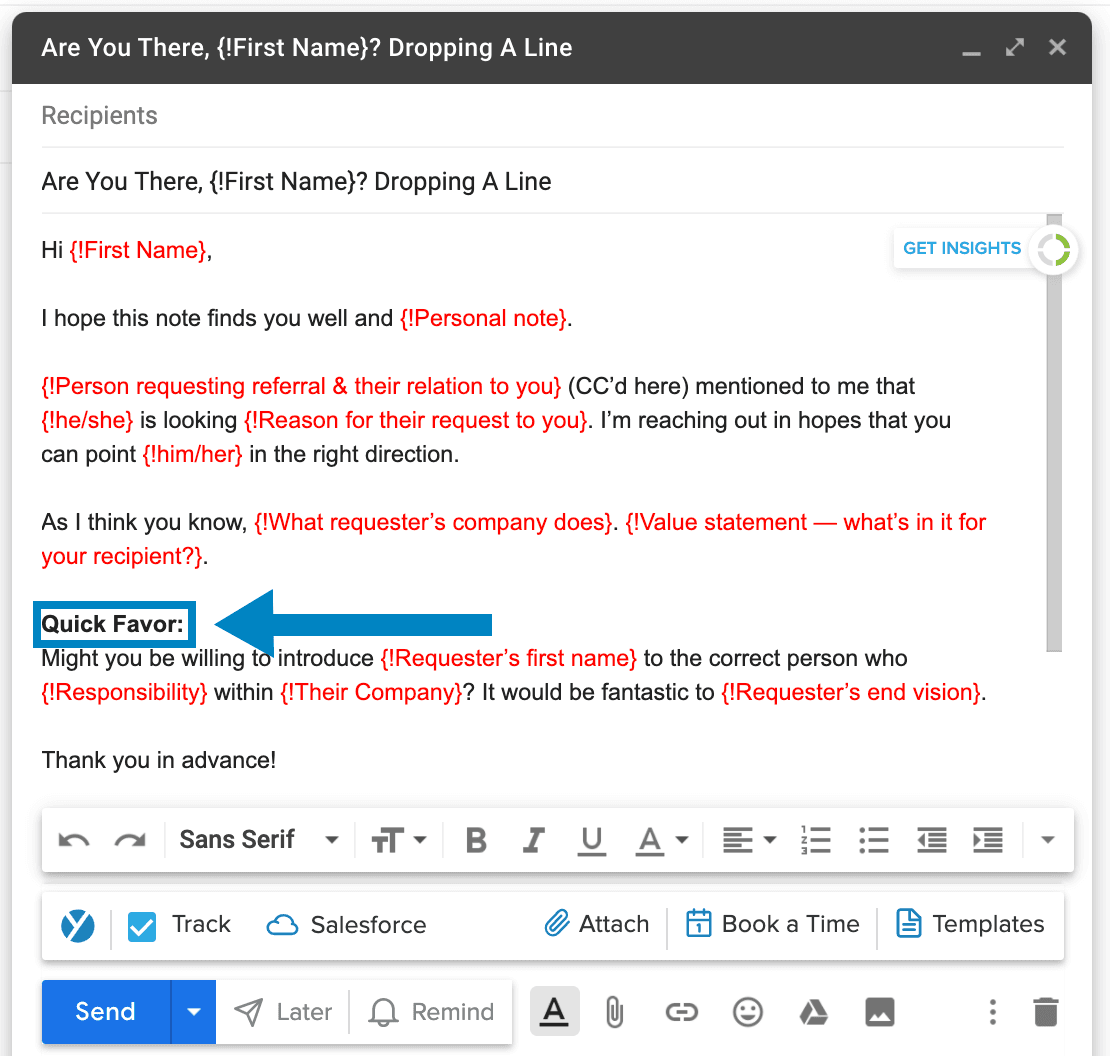
Another way you can make sure your email is easy to read and navigate is to use bullet points or numbers to separate your ideas.
This way your recipient can skim your email and still gather important pieces of information.
If you make it easier for your recipients to find the main points of the message before clicking away, they’re likely to stay on your message longer — so make the information listed in bullet points catchy and valuable.
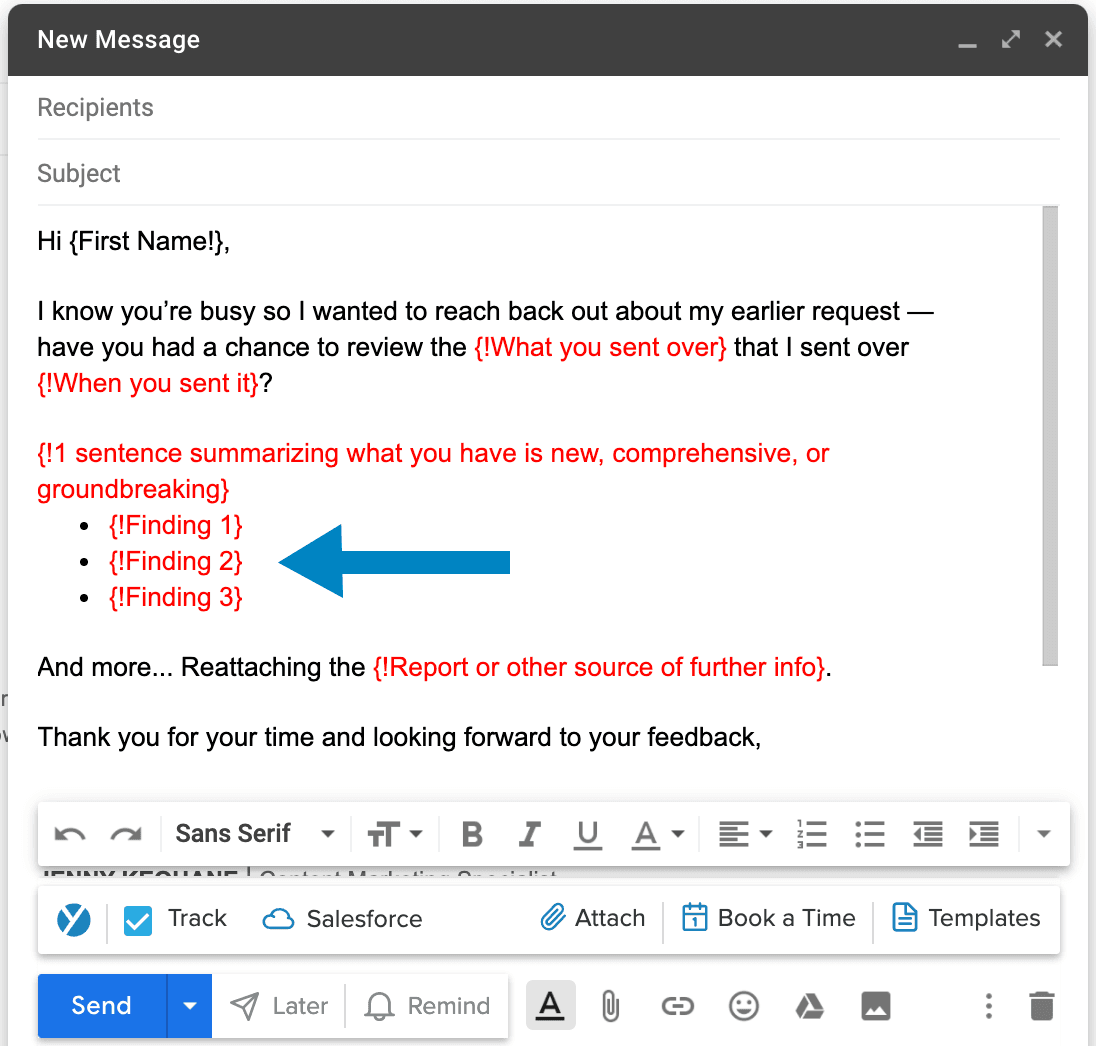
After you type your message, read over and trim unnecessary sentences.
2. Use Proper Email Etiquette
When writing professional emails, it’s also important to pay attention to proper email etiquette rules.
Here are some of the most important rules to keep in mind:
- Use a professional email address
- Always proofread before clicking send
- Use simple and classic fonts
- Use readable font sizes (11 or 12-point font size)
- Keep your tone professional
- Use precautions when sending attachments
3. Make CC and BCC Work for You
A common misconception in email format is the use of CC vs. BCC. It’s important to know when to use each of these and get your message into the right hands.
Below are the best ways to use CC and BCC to your advantage. But first, a refresher:
CC (carbon copy): A visible recipient list.
BCC (blind carbon copy): An invisible recipient list.
Use CC when you want to:
- Be transparent about who is on the email
- Add someone to the thread so they’re in the loop, with no action required
- Start an email thread with others
When you’re using the CC option, try this simple email greeting template:
(CCing {!Person1}, {!Person2}, {!Person3}, and {!Person4} for visibility.)

Use BCC when you want to:
- Hide recipients – ex: when messaging a customer, you could BCC your manager to keep them in the loop
- Stop sending emails to people who don’t need every reply – moving recipients to BCC ensures that the next reply-all that happens on a thread won’t go to them
Through the thread, if you’re moving recipients to BCC, use this:
[Moving {!Person1}, {!Person2}, and {!Person3} to BCC to spare their inboxes.]

Professional Email Message Templates
To help you get started — here are some already-formatted email templates you can copy and use today.
1. Valuable Cold Outreach
Writing cold emails is an art form. You need to make someone trust you without meeting them.
Build rapport by providing them with relevant and helpful content.
Here’s a quick way to stop them from skimming and add value:
Hi {!FirstName},
My name is {!Your Name} and I {!connection to recipient}.
The last few calls I’ve had with companies like yours who {!specific stats about the recipient’s company} have led me to research {!topic that could be a pain point for them}.
I thought you would appreciate these articles. I thought they did a great job at addressing {!pain point}:
{!Link to content 1} – {!description of content 1}
{!Link to content 2} – {!description of content 2}
{!Link to content 3} – {!description of content 3}
If these resonated with you, let’s grab 15 minutes to see if {!Your Company} can help by {!proposed solution for solving pain point}.
Is there a day or time that generally works best for you?
Looking forward to talking,
[Your Name] [Email Signature Block]
2. Referral Introduction Email
If you’re giving someone the introduction email they deserve, it’s important to get straight to the details.
You’re asking for valuable time from your recipient.
Here’s a referral introduction email format to copy/paste:
Hi {!First Name},
I hope this note finds you well and {!personal note}.
My name is {!Your name} and I’m {!Job title} at {!Company}. I’m reaching out because {!Mutual connection} (CC’d here) mentioned that {!reason for refferal}.
I understand from {!Mutual connection} that {!reason for connect}. I believe I can help by {!solution}.
I’d love to schedule some talk to talk, {!call to action}.
Thank you for your time and I look forward to hearing back.
Sincerely,
[Your Name] [Email Signature Block]
3. Professional Meeting Recap Email
You just had an important meeting and want to make sure everyone is on the same page.
What better way to do this than to compile your next steps into an email sent after the meeting?
Try this meeting recap template:
Hey {!Company name} team,
Great meeting with you today — thank you for your time and for {!coming by the office/sharing in a discussion}.
I’m looking forward to talking again on {!agreed upon date}. I’ll send you a calendar invite for that shortly.
Lastly, can you confirm that I recapped our discussion accurately?
Your Current {!Initiatives / Priorities / Goals}:
{!Priority 1}
{!Priority 2}
{!Priority 3}
Agreed Upon Next Steps:
{!First Action + date} — {!Owner 1}
{!Second Action + date} — {!Owner 2}
Best,
[Your Name] [Email Signature Block]
Tip: Grab more formatted email templates below.
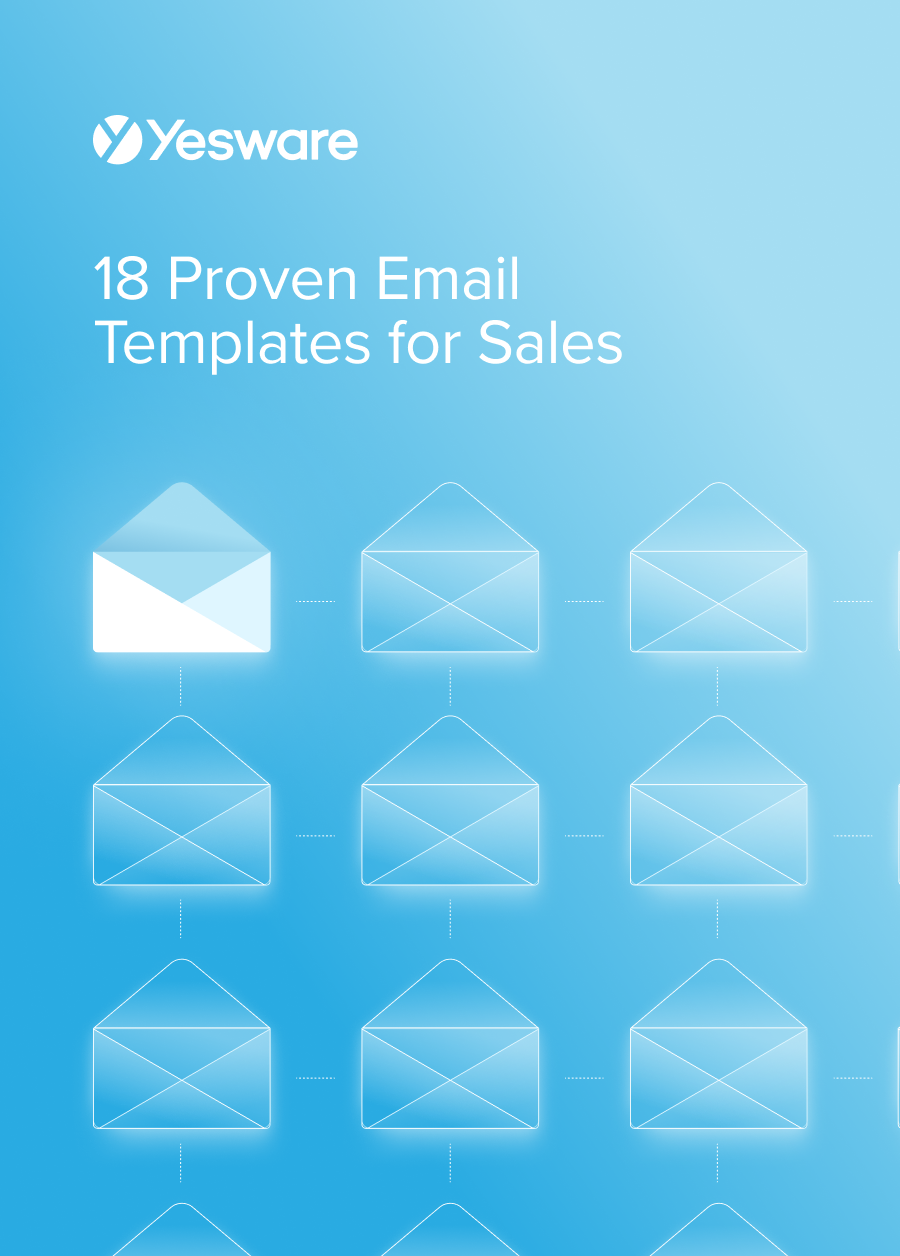 18 Proven Email TemplatesWinning email templates for cold outreach, follow-ups, and nurturing relationships – backed by data and real-world examples.
18 Proven Email TemplatesWinning email templates for cold outreach, follow-ups, and nurturing relationships – backed by data and real-world examples.4. Networking Follow-Up Email
After you meet someone in person, it’s important to send a follow-up email to reinforce the connection.
Why? Making the effort to reach out to someone, they feel more obliged to reciprocate.
Here’s a formatted template that does just that:
Hi {!FirstName},
This is {!Your Name} from {!Company}. It was great meeting you at {!Event where you met}. I loved learning more about {!something discussed}.
I’m really interested in hearing more about your role as {!Job title} at {!Company}, as {!reason why you’re interested}. If you have time in the coming weeks, let’s {!follow-up action}.
I’m generally free on {!Days of the week}, does one of those work for you?
Looking forward to keeping in touch!
[Your Name] [Email Signature Block]
5. Job Application Email Introduction
When sending job application email introductions, proper email format is essential.
Here’s an email template for a job application that’s properly formatted:
Dear {!First name},
My name is {!Your Name} and I {!brief introduction}. I saw your job posting on {!Website} and am very interested in the position.
I believe I’m a strong candidate for this position because {!your experience}.
Please find my attached {!cover letter/resume} below. If I can provide you with any further materials, please don’t hesitate to reach out. You can email me at {!email address} or call me at {!phone number}.
Thank you so much for your time and consideration.
Sincerely,
[Your Name] [Email Signature Block]
Grab 20 more professional email templates here –> Business Email Examples
Conclusion
Although every email you write is different, it’s important to follow proper email formatting techniques to ensure your making a good impression.
One of the best ways to consistently write emails with proper email format is to save them as templates and re-use them.
Always adjust and personalize each template accordingly.
Get sales tips and strategies delivered straight to your inbox.
Yesware will help you generate more sales right from your inbox. Try our Outlook add-on or Gmail Chrome extension for free, forever!
Related Articles
Jenny Keohane
Jenny Keohane
Melissa Williams
Sales, deal management, and communication tips for your inbox

